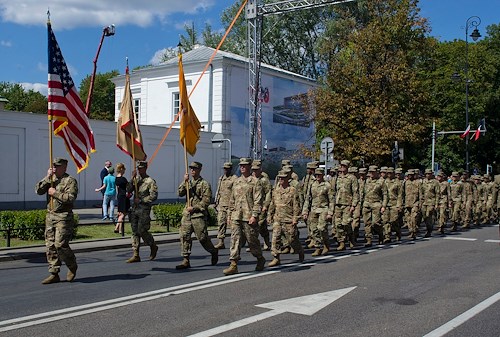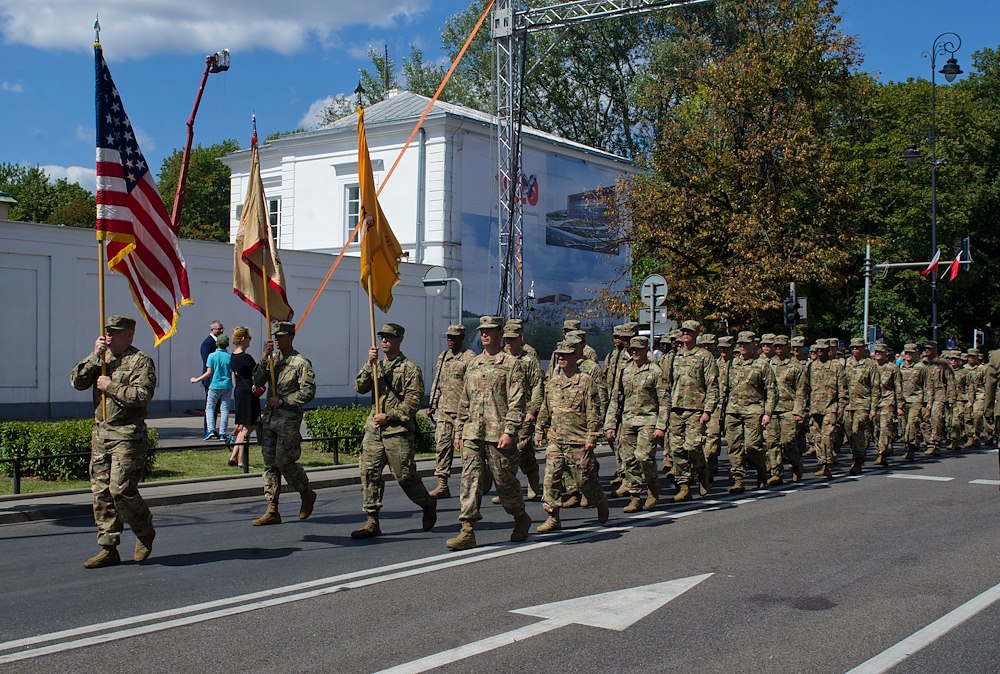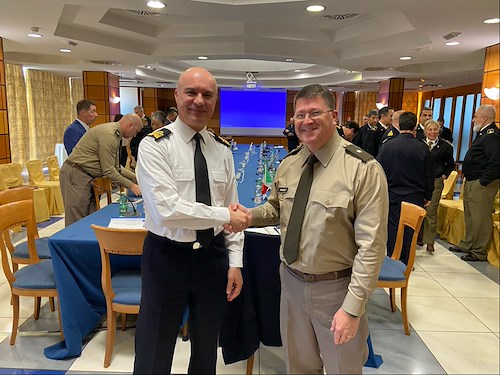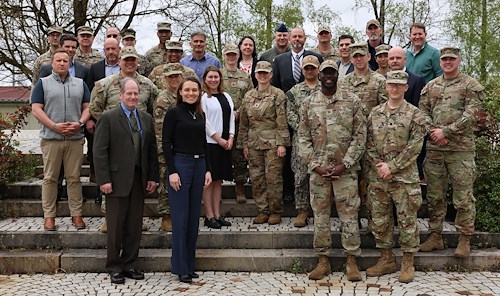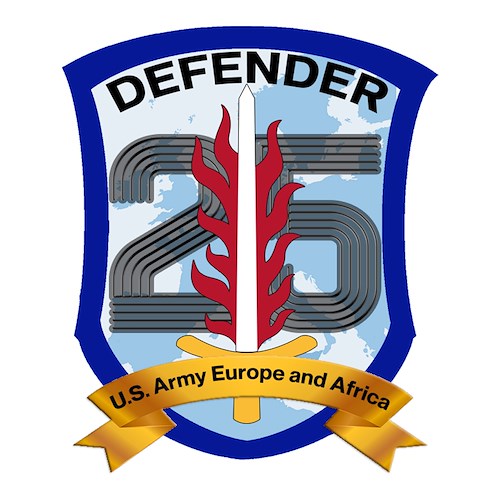Gallery contains 5 images
×
Photo 1 of 5
NATO Allies unite to commemorate the 97th anniversary of the Battle of Warsaw
Soldiers assigned to the 497th Combat Sustainment Support Battalion marched down the capital of Poland during the 97th anniversary of the Battle of Warsaw Aug. 15, 2017, in Warsaw, Poland. This national holiday in Poland, known as the Feast of the Polish Armed Forces, which included Soldiers from Canada, Estonia, Romania, United States and the United Kingdom. As part of the unified Alliance, the NATO Soldiers and their collective combat vehicles participated in the annual Polish parade to celebrate that historic victory and honor active duty services members, veterans and fallen Soldiers.
Photo by: Sgt. Justin Geiger
Photo 2 of 5
NATO Allies unite to commemorate the 97th anniversary of the Battle of Warsaw
U.S. Strykers with the 2nd Squadron, 2nd Cavalry Regiment drove passed the parade tower during the 97th anniversary of the Battle of Warsaw Aug. 15, 2017, in Warsaw, Poland. This national holiday in Poland, known as the Feast of the Polish Armed Forces, included Soldiers from Canada, Estonia, Romania, United States and the United Kingdom. As part of the unified Alliance, the NATO Soldiers and their collective combat vehicles participated in the annual Polish parade to celebrate that historic victory and honor active duty services members, veterans and fallen Soldiers
Photo by: Sgt. Justin Geiger
Photo 3 of 5
NATO Allies unite to commemorate the 97th anniversary of the Battle of Warsaw
U.S. Ambassador to Poland, Paul W. Jones and Commanding General of U.S. Army Europe, Lt. Gen. Ben Hodges thanked the Soldiers assigned to the 497th Combat Sustainment Support Battalion for participating in 97th anniversary of the Battle of Warsaw Aug. 15, 2017, in Warsaw, Poland. This national holiday in Poland, known as the Feast of the Polish Armed Forces, included Soldiers from Canada, Estonia, Romania, United States and the United Kingdom. As part of the unified Alliance, the NATO Soldiers and their collective combat vehicles participated in the annual Polish parade to celebrate that historic victory and honor active duty services members, veterans and fallen Soldiers.
Photo by: Sgt. Justin Geiger
Photo 4 of 5
NATO Allies unite to commemorate the 97th anniversary of the Battle of Warsaw
Soldiers assigned to the 497th Combat Sustainment Support Battalion participated in the 97th anniversary of the Battle of Warsaw Aug. 15, 2017, in Warsaw, Poland. This national holiday in Poland, known as the Feast of the Polish Armed Forces, included Soldiers from Canada, Estonia, Romania, United States and the United Kingdom. As part of the unified Alliance, the NATO Soldiers and their collective combat vehicles participated in the annual Polish parade to celebrate that historic victory and honor active duty services members, veterans and fallen Soldiers.
Photo by: Sgt. Justin Geiger
Photo 5 of 5
NATO Allies unite to commemorate the 97th anniversary of the Battle of Warsaw
Minister of National Defense, Antoni Macierewicz thanked the Commanding General of U.S. Army Europe, Lt. Gen. Ben Hodges for his service during the 97th anniversary of the Battle of Warsaw Aug. 15, 2017, in Warsaw, Poland. This national holiday in Poland, known as the Feast of the Polish Armed Forces, which included soldiers from Canada, Estonia, Romania, United States and the United Kingdom. As part of the unified Alliance, the NATO Soldiers and their collective combat vehicles participated in the annual Polish parade to celebrate that historic victory and honor active duty services members, veterans and fallen Soldiers.
Photo by: Sgt. Justin Geiger
President of the Republic of Poland, Andrzej Duda; Minister of National Defense, Antoni Macierewicz; U.S. Ambassador to Poland, Paul W. Jones; Commanding General of U.S. Army Europe, Lt. Gen. Ben Hodges; other military delegates and political officials stood shoulder-to-shoulder to commemorate the 97th anniversary of the Polish victory over Soviet Russia in 1920 during the Battle of Warsaw.
This national holiday in Poland, known as the Feast of the Polish Armed Forces, included Soldiers from Canada, Estonia, Romania, United States and the United Kingdom. As part of the unified Alliance, the NATO Soldiers and their collective combat vehicles participated in the annual Polish Parade to celebrate that historic victory and honor active duty services members, veterans and fallen Soldiers Aug. 15, 2017, in Warsaw, Poland.
Before each nation’s Soldiers and their vehicle paraded down the capital of Poland, the event began with President Duda addressing the large crowd in attendance and the Allied Soldiers partaking in the ceremony alongside their Polish counterparts. As part his opening speech, the President of Poland took the time to recognize Lt. Gen Hodges and presented him with the Commander’s Cross with the star of the Order of Merit of the Republic of Poland.
This Polish Award was rendered to the Commanding General of U.S. Army Europe for his service in improving the professional relationship between Poland and U.S. forces, and his contributions toward the continuous efforts to strengthen the security and stability of Eastern Europe in support of Operation Atlantic Resolve.
“Poland is a leader in NATO, we just saw some of their quality equipment and capabilities, and more important than that equipment is the well-trained men and women operating it,” said Hodges during a press conference. “The leadership of the Polish military makes them a very reliable Ally, but it’s a manifestation of Poland’s commitment to the security of the Alliance.”
“So to be here today, have our Soldiers and some of our capabilities take part in the parade and to receive an award from the President of Poland is a lifetime memory for me,” he added.
The Soldiers who participated in the parade that made Hodges “very proud” were from the 497th Combat Sustainment Support Battalion; the 2nd Squadron, 2nd Cavalry Regiment, and the 12th Combat Aviation Brigade.
Following the completion of the parade, Paul Jones, the U.S. Ambassador to Poland, also took a moment to express his thoughts on having U.S. forces and several other Allied nations contribute to strengthening NATO’s eastern flank in Europe.
“I think the work that we’re doing today between our militaries and our countries is a transformational turning point in the capabilities and the unity of NATO, especially in this region" said Jones. "I think Poland is a big part of that and I think we observed that as part of the parade.”
The parade also included a variety of Polish and U.S. aircraft, a polish re-enactment formation and a Polish Cavalry unit, which demonstrated that Soldiers in the Alliance training together to deter any potential aggression, those Soldiers also celebrate local customs and traditions together.
“I’m very proud to have been apart of seeing Poland and the United States become such strong and reliable Allies to each other, which is a tradition that goes back 242 years,” said Hodges. “I think as long as the nations in our Alliance, the most successful Alliance in the world, continue to stick together and invest in its own security like Poland does, then any sort of aggression is unlikely. We also want to make it unthinkable because we are so strong together that no potential adversary would ever seriously consider any aggression toward our Alliance.”
---
U.S. Army Europe is uniquely positioned in its 51 country area of responsibility to advance American strategic interests in Europe and Eurasia. The relationships we build during more than 1,000 theater security cooperation events in more than 40 countries each year lead directly to support for multinational contingency operations around the world, strengthen regional partnership and enhance global security.

